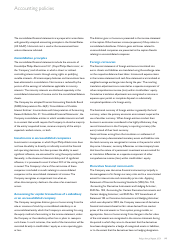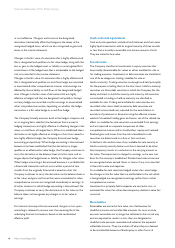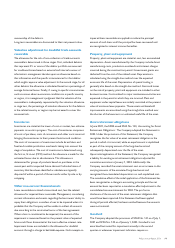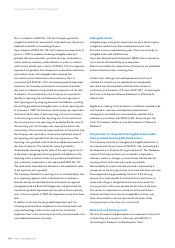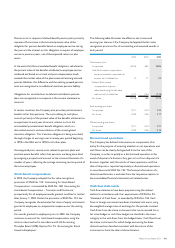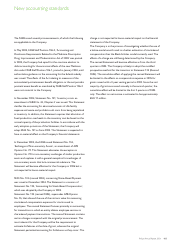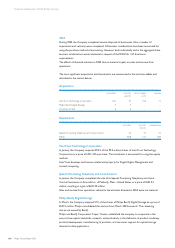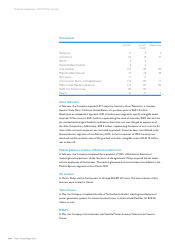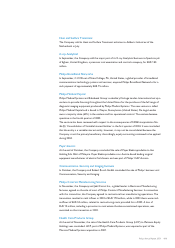Philips 2004 Annual Report Download - page 103
Download and view the complete annual report
Please find page 103 of the 2004 Philips annual report below. You can navigate through the pages in the report by either clicking on the pages listed below, or by using the keyword search tool below to find specific information within the annual report.equipment has been finalized in accordance with the contractually
agreed specifications and therefore the product is ready to be
used by the customer, and subsequently a signed acceptance
protocol has been obtained from the customer, or, in cases where
such acceptance protocol is not contractually required, when
management has established on the basis of installation and
workflow protocols that the product has been installed and is
ready to be used by the customer in the way contractually agreed.
Typically, installation activities include, to a certain extent,
assembly of the equipment on the spot. Any payments by the
customer are typically contingent upon the completion of the
installation process in accordance with the contractual
requirements and therefore, in such instances, revenue
recognition with respect to the equipment delivery is deferred
until the installation process is completed.
Revenues are recorded net of sales taxes, customer discounts,
rebates and similar charges. For products for which a right of
return exists during a defined period, revenue recognition is
determined based on the historical pattern of actual returns, or in
cases where such information is lacking, revenue recognition is
postponed until the return period has lapsed. Return policies are
typically in conformity with customary return arrangements in
local markets.
For products for which a residual value guarantee has been
granted or a buy-back arrangement has been concluded, revenue
recognition takes place in accordance with the requirements for
lease accounting of SFAS No.13, ‘Accounting for Leases’.
Shipping and handling costs billed to customers are recognized as
revenues. Expenses incurred for shipping and handling costs of
internal movements of goods are recorded as cost of sales.
Shipping and handling costs related to sales to third parties are
reported as selling expenses and disclosed separately.
Service revenue related to repair and maintenance activities for
sold goods is recognized ratably over the service period or as
services are rendered.
A provision for product warranty is made at the time of revenue
recognition and reflects the estimated costs of replacement and
free-of-charge services that will be incurred by the Company with
respect to the sold products. In cases where the warranty period
is extended and the customer has the option to purchase such an
extension, which is subsequently billed separately to the customer,
revenue recognition occurs on a straight-line basis over the
contract period.
Royalty income, which is generally earned based upon a
percentage of sales or a fixed amount per product sold, is
recognized on an accrual basis. Government grants, other than
those relating to purchases of assets, are recognized as income as
qualified expenditures are made.
EITF Issue No. 00-21, ‘Revenue Arrangements with Multiple
Deliverables’, which has been adopted in 2003, applies to some
arrangements that occur in the Medical Systems businesses on
delivery of equipment that requires subsequent installation and
training activities in order to become operable for the customer.
However, since payment for the equipment is typically contingent
upon the completion of the installation process, revenue
recognition is required to be deferred until the installation has
been completed. The Company recognizes revenues of the other
deliverables based on their relative fair values.
Income taxes
Income taxes are accounted for using the asset and liability
method. Income tax is recognized in the income statement except
to the extent that it relates to an item recognized directly within
stockholders’ equity, including other comprehensive income (loss),
in which case the related tax effect is also recognized there.
Current tax is the expected tax payable on the taxable income for
the year, using tax rates enacted at the balance sheet date, and any
adjustment to tax payable in respect of previous years. Deferred
tax assets and liabilities are recognized for the expected tax
consequences of temporary differences between the tax bases of
assets and liabilities and their reported amounts. Measurement of
deferred tax assets and liabilities is based upon the enacted tax
rates expected to apply to taxable income in the years in which
those temporary differences are expected to be recovered or
settled. Deferred tax assets, including assets arising from loss
carryforwards, are recognized if it is more likely than not that the
asset will be realized. Deferred tax assets and liabilities are not
discounted.
Deferred tax liabilities for withholding taxes are recognized for
subsidiaries in situations where the income is to be paid out as
dividends in the foreseeable future, and for undistributed earnings
of minority shareholdings.
Changes in tax rates are reflected in the period that includes the
enactment date.
Benefit accounting
The Company accounts for the cost of pension plans and
postretirement benefits other than pensions in accordance with
SFAS No. 87, ‘Employers’ Accounting for Pensions’, and SFAS No.
106, ‘Postretirement Benefits other than Pensions’, respectively.
Most of the Company’s defined-benefit plans are funded with plan
assets that have been segregated and restricted in a trust to
provide for the pension benefits to which the Company has
committed itself.
When plan assets have not been segregated the Company
recognizes a provision for such amounts.
102 Philips Annual Report 2004
Financial statements of the Philips Group







